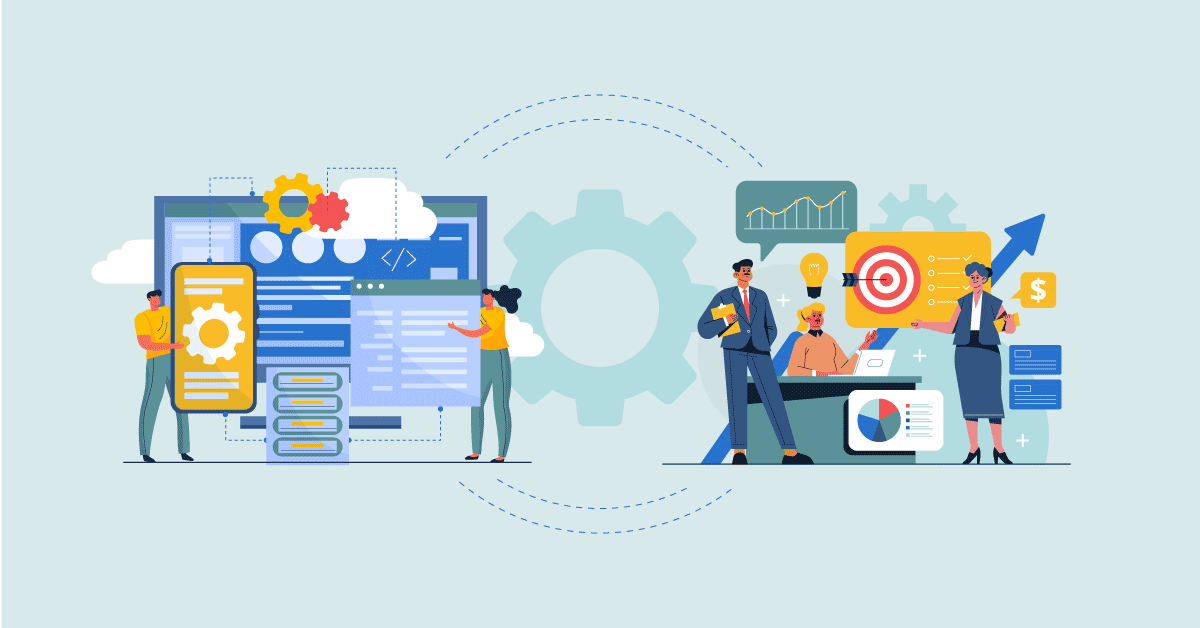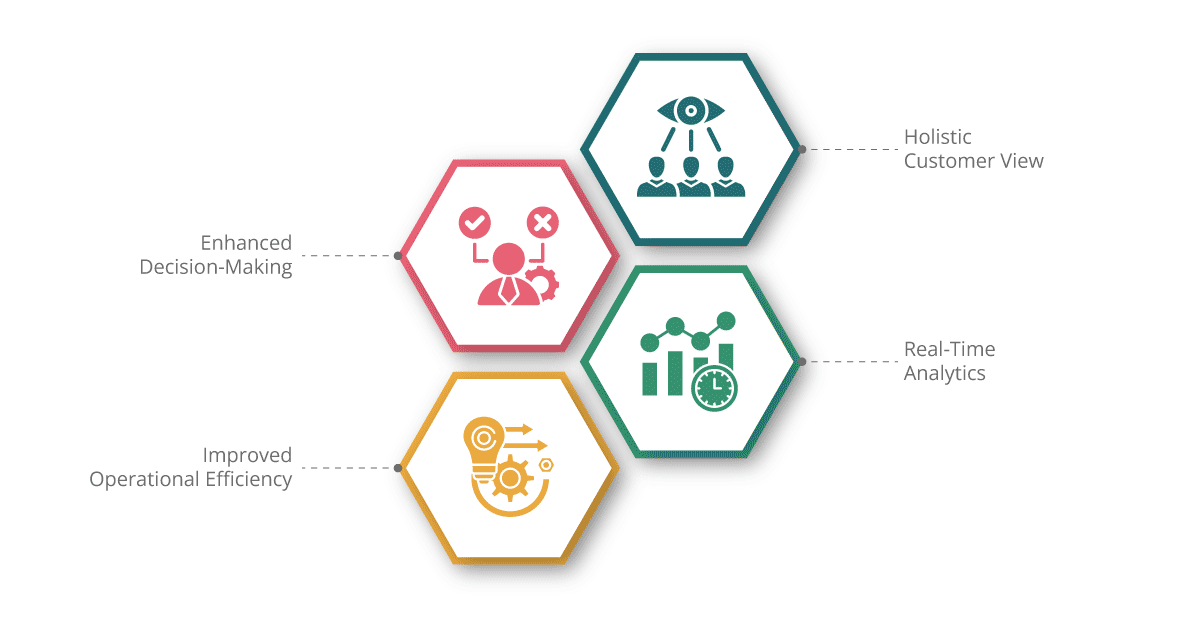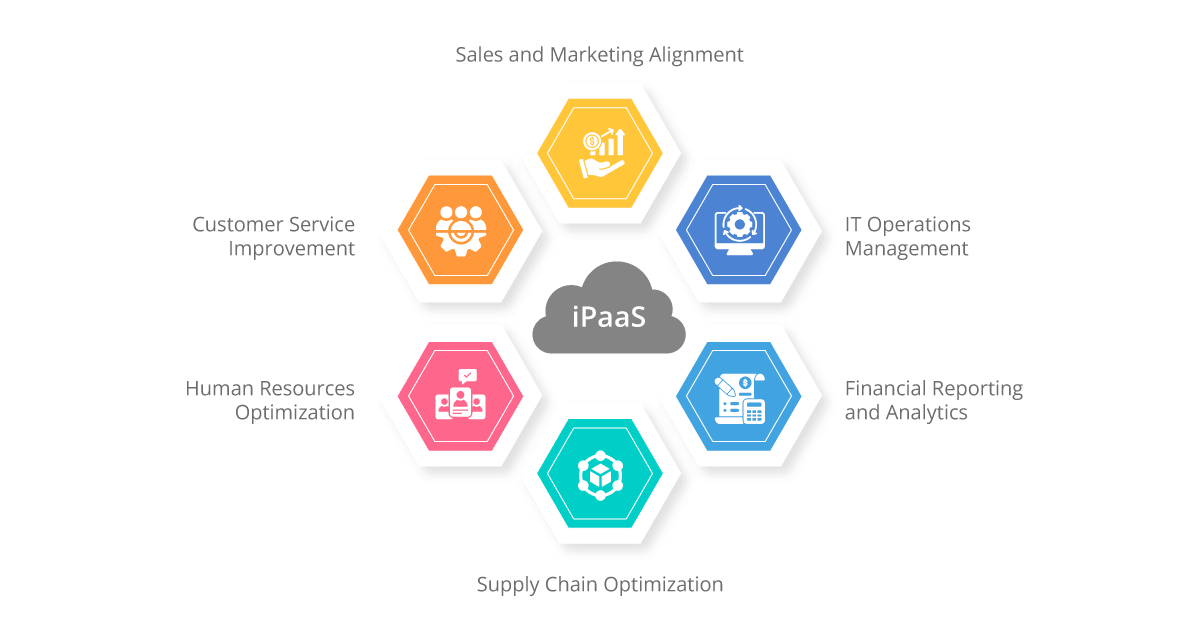Data has become the lifeblood of organizations in today’s rapidly evolving digitized ecosystem. Companies that can harness the power of data and derive actionable insights gain a significant competitive advantage. To achieve this, businesses need robust data integration strategies that seamlessly consolidate and harmonize disparate data sources. In this article, we will explore the importance of data integration for business intelligence and discuss how it can pave the way for building a data-driven organization.
Aonflow iPaaS – Free for First 3 Months!
Build and run up to 1,500 transactions monthly with no cost. No payment info needed!
Understanding Data Integration
Data integration refers to the process of combining data from different sources, formats, and systems to create a unified and consistent view. It involves extracting, transforming, and loading (ETL) data to ensure its quality, accuracy, and reliability. Let’s delve into the key aspects of data integration:
Data Consolidation:
Data consolidation involves gathering data from various internal and external sources, such as databases, cloud services, applications, and APIs. For example, a retail company may combine data from point-of-sale systems, customer relationship management (CRM) platforms, e-commerce platforms, and social media to gain a holistic view of customer behavior and preferences. By consolidating these disparate data sources, the organization can gain a comprehensive understanding of customer interactions and optimize marketing strategies accordingly.
Data Transformation:
Data often exists in different formats and structures. Data integration includes transforming data into a standardized format for easy analysis and interpretation. For instance, a healthcare organization may need to integrate patient data from electronic health records (EHRs) in various formats. By standardizing the data structure and ensuring consistency, the organization can gain insights into patient outcomes, identify trends, and improve healthcare delivery.
Data Loading:
Once data is consolidated and transformed, it needs to be loaded into a centralized data warehouse or data lake. This ensures accessibility and availability for business intelligence tools and analytics platforms. For example, an e-commerce company may load data from multiple sources, such as website interactions, customer reviews, and sales transactions, into a data warehouse. This central repository allows the company to analyze customer behavior, identify patterns, and make data-driven decisions regarding product recommendations, inventory management, and marketing campaigns.
Benefits of Data Integration for Business Intelligence
Effective data integration is the cornerstone of successful business intelligence initiatives. Here are some key benefits:
Enhanced Decision-Making:
By integrating data from various sources, organizations gain a comprehensive and accurate view of their operations, customers, and market trends. This enables informed decision-making based on reliable insights rather than assumptions. For instance, a manufacturing company integrating data from production systems, supply chain systems, and customer feedback can optimize production schedules, minimize lead times, and improve overall customer satisfaction.
Improved Operational Efficiency:
Data integration eliminates silos and enhances data accessibility. It enables different departments to share and access relevant data, promoting collaboration and streamlining processes. For example, a retail organization integrating data from inventory management systems, point-of-sale systems, and e-commerce platforms can optimize inventory levels, reduce stockouts, and improve order fulfillment.
Holistic Customer View:
Integrating customer data from multiple touchpoints helps build a 360-degree view of customers. This allows businesses to personalize marketing campaigns, improve customer service, and anticipate future needs. For instance, a telecommunications company integrating data from call logs, customer complaints, and social media can proactively address customer issues, identify upselling opportunities, and enhance customer retention.
Real-Time Analytics:
Data integration enables organizations to perform real-time analytics, empowering them to make timely decisions. For example, a financial institution integrating data from transactional systems, market data feeds, and external news sources can monitor market trends, assess risk, and make real-time investment decisions.
How iPaaS Connects with Data Integration
Integration Platform as a Service (iPaaS) solutions provide a cloud-based platform for integrating diverse applications, data sources, and systems. iPaaS plays a crucial role in data integration for business intelligence by offering the following capabilities:
Seamless Connectivity:
iPaaS provides pre-built connectors and adapters to integrate data sources, applications, and APIs without the need for complex coding. It enables organizations to establish seamless connectivity between various systems, ensuring data flows smoothly. For example, a marketing team can use iPaaS to integrate customer data from CRM systems, email marketing platforms, and social media platforms, enabling targeted marketing campaigns based on customer preferences and behavior.
Data Transformation and Mapping:
iPaaS platforms offer intuitive interfaces for transforming and mapping data between different formats, ensuring compatibility across systems. This simplifies the data integration process and reduces the time required for development and deployment. For instance, an insurance company can use iPaaS to transform and map data from policy management systems, claims systems, and third-party data providers, enabling a unified view of policyholders and claims data for efficient risk assessment and underwriting.
Workflow Automation:
iPaaS solutions enable the automation of data integration workflows, allowing organizations to schedule and orchestrate data movements and transformations. This helps in maintaining data freshness and accuracy. For example, a logistics company can automate the integration of data from transportation management systems, warehouse management systems, and GPS tracking systems via iPaaS. This ensures real-time visibility into shipment statuses, optimized route planning, and proactive issue resolution.
Aonflow is the leading integration platform.
You can kick-start by integrating your first-ever workflow in just a matter of minutes.
iPaaS Use Cases in Data Integration for Business Intelligence
Here are use cases illustrating how iPaaS can be utilized for data integration in business intelligence:
Sales and Marketing Alignment:
An organization integrating customer relationship management (CRM) systems with marketing automation platform via iPaaS can achieve a unified view of customer interactions. This integration enables marketing teams to tailor campaigns based on customer preferences, resulting in higher conversion rates and improved ROI. For example, a retail company can integrate CRM data with an email marketing platform to send personalized product recommendations to customers based on their purchase history and preferences.
Supply Chain Optimization:
An iPaaS solution can integrate data from suppliers, inventory systems, and demand forecasting tools. This integration enables organizations to streamline their supply chain processes, minimize stockouts, and optimize inventory levels. For instance, a manufacturing company can integrate supplier data, production data, and demand forecasts to ensure timely procurement, efficient production planning, and reduced holding costs.
Financial Reporting and Analytics:
By integrating financial data from various sources, such as accounting systems, ERP platforms, and external market data, iPaaS enables organizations to generate comprehensive financial reports and perform in-depth financial analyses. This integration provides real-time visibility into financial performance and facilitates strategic decision-making. For example, a multinational corporation can integrate financial data from its subsidiaries worldwide, enabling consolidated financial reporting and analysis for better financial planning and risk management.
Customer Service Improvement:
Integrating data from customer service platforms, ticketing systems, and social media platforms via iPaaS allows organizations to gain insights into customer sentiment, preferences, and behavior. This integration enables businesses to provide personalized and proactive customer service. For example, a hospitality company can integrate guest feedback from various sources, such as online reviews and surveys, to identify areas of improvement and tailor guest experiences.
Fraud Detection:
By integrating data from multiple sources, such as transactional systems, customer behavior analytics, and external fraud databases, iPaaS can help organizations detect and prevent fraudulent activities. For instance, a financial institution can integrate transaction data, customer profiles, and fraud detection algorithms to identify suspicious patterns, trigger alerts, and mitigate potential risks.
Healthcare Analytics:
Integrating data from electronic health records (EHRs), medical devices, and research databases via iPaaS enables healthcare organizations to gain comprehensive insights into patient outcomes, treatment effectiveness, and population health. This integration can facilitate evidence-based decision-making, personalized medicine, and improved patient care.
Human Resources Optimization:
Integrating data from HR systems, employee performance platforms, and recruitment tools via iPaaS allows organizations to analyze workforce data, identify talent gaps, and optimize HR processes. For example, a large enterprise can integrate employee data from different subsidiaries to gain insights into workforce demographics, employee engagement, and performance metrics for strategic workforce planning.
Social Media Analytics:
An iPaaS solution can integrate data from social media platforms, sentiment analysis tools, and customer engagement systems. This integration enables organizations to monitor brand sentiment, track customer interactions, and identify emerging trends. For instance, a retail company can integrate social media data to analyze customer sentiment, identify product preferences, and adjust marketing strategies accordingly.
IT Operations Management:
Integrating data from various IT systems, network monitoring tools, and service management platforms via iPaaS helps organizations gain insights into IT infrastructure performance, identify bottlenecks, and improve service delivery. For example, a technology company can integrate data from server logs, network devices, and incident management systems to proactively monitor and manage IT operations, ensuring optimal system performance and minimizing downtime.
IoT Data Integration:
With the rise of the Internet of Things (IoT), iPaaS can play a vital role in integrating data from IoT devices, sensors, and analytics platforms. This integration enables organizations to harness IoT-generated data for predictive maintenance, asset tracking, and real-time monitoring. For instance, a manufacturing company can integrate data from IoT sensors embedded in machinery to proactively detect equipment failures, scheduled maintenance, and optimize production processes.
E-commerce Analytics:
Integrating data from e-commerce platforms, customer reviews, and web analytics tools via iPaaS enables organizations to gain insights into customer purchasing behavior, product performance, and website engagement. This integration can help optimize pricing strategies, identify popular products, and enhance the overall online shopping experience. For example, an e-commerce retailer can integrate data from multiple sales channels to analyze customer preferences and create targeted promotions for specific customer segments.
Risk Management and Compliance:
Integrating data from risk management systems, regulatory databases, and internal controls via iPaaS allows organizations to proactively manage risks and ensure compliance with industry regulations. This integration enables real-time monitoring of risk indicators, identification of potential compliance breaches, and implementation of corrective actions. For instance, a financial institution can integrate data from multiple sources to assess credit risk, monitor transaction patterns, and detect potentially fraudulent activities.
Energy Consumption Optimization:
An iPaaS solution like Aonflow can integrate data from smart meters, energy management systems, and weather forecasts to optimize energy consumption in commercial buildings. This integration enables organizations to analyze energy usage patterns, identify inefficiencies, and implement energy-saving strategies. For example, a property management company can integrate data from smart meters to monitor energy consumption in different buildings, identify areas of high consumption, and implement energy-efficient measures to reduce costs and environmental impact.
Supplier Performance Analytics:
iPaaS facilitates the integration of data from supplier databases, procurement systems, and performance evaluation tools. This integration empowers businesses to assess and analyze supplier performance metrics comprehensively. For instance, a manufacturing company utilizing iPaaS can amalgamate supplier delivery times, quality compliance data, and pricing structures. By visualizing this integrated data through BI tools, organizations gain insights into supplier reliability, cost-effectiveness, and quality consistency. This enables informed decision-making regarding supplier partnerships, negotiation strategies, and streamlining procurement processes, ultimately optimizing supply chain efficiency and driving cost savings.
Predictive Maintenance:
Integrating data from IoT sensors, equipment logs, and maintenance systems via iPaaS enables organizations to implement predictive maintenance strategies. This integration allows real-time monitoring of equipment performance, early detection of potential failures, and proactive maintenance scheduling. For example, a manufacturing plant can integrate sensor data from production machinery to analyze equipment health, predict maintenance requirements, and minimize downtime by conducting maintenance activities when necessary.
Inventory and Demand Planning:
Integrating data from inventory management systems, sales data, and demand forecasting tools via iPaaS allows organizations to optimize inventory levels and streamline demand planning processes. This integration enables real-time visibility into stock levels, sales trends, and customer demand, facilitating accurate inventory replenishment and minimizing stockouts or overstocking. For example, a retail company can integrate data from point-of-sale systems, inventory management software, and market demand forecasts to ensure optimal inventory levels, reduce carrying costs, and meet customer demands efficiently.
Quality Control and Defect Analysis:
By integrating data from quality control systems, production logs, and customer feedback platforms via iPaaS, organizations can effectively monitor product quality and identify potential defects or issues. This integration enables real-time analysis of quality data, enabling timely corrective actions and continuous improvement efforts. For instance, a manufacturing company can integrate data from quality control checkpoints, production records, and customer complaints to identify patterns of defects, pinpoint root causes, and implement preventive measures to enhance product quality and customer satisfaction.
The versatility and effectiveness of iPaaS in data integration for business intelligence are evident through these use cases. With iPaaS as a powerful ally, organizations can unleash the true potential of their data assets.
Endnote
Data integration is the bedrock of building a data-driven organization. By bringing together diverse data sources and ensuring their compatibility and consistency, businesses can harness the power of data to gain actionable insights and make informed decisions. iPaaS solutions have emerged as a game-changer in the field of data integration, offering organizations a comprehensive platform for seamless connectivity, data transformation, and workflow automation.
With iPaaS, businesses can streamline their data integration processes, reducing manual effort and increasing operational efficiency. The ability to connect and integrate various systems, applications, and data sources enables organizations to break down data silos, enabling a holistic view of their operations and customers. This, in turn, empowers organizations to make data-driven decisions, improve customer experiences, optimize business processes, and drive innovation.
Embracing data integration and leveraging iPaaS solutions enable organizations to unlock the full potential of their data assets. They can build a foundation for becoming truly data-driven, gaining a competitive edge in today’s fast-paced and data-intensive business landscape. In this era of digital transformation, data integration, and iPaaS serve as catalysts for organizational growth, enabling businesses to adapt, innovate, and thrive in an increasingly interconnected world.
Aonflow iPaaS – Free for First 3 Months!
Build and run up to 1,500 transactions monthly with no cost. No payment info needed!


